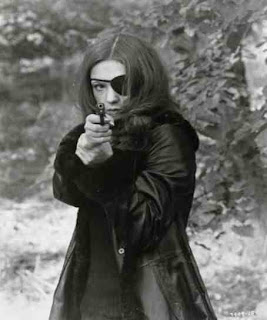
A group of college kids, travelling through hillbilly country on vacation, stop off at a gas station for fuel and beer. Two dungaree-clad good ol’ boys regard them with silent suspicion. Shortly afterwards, one of them approaches the kids. He’s carrying a scythe and grins as he asks them, “You kids goin’ campin’?”, following up the query with an edgy laugh.
Later, under the impression that these selfsame individuals have kidnapped one of their number – psychology student Alison (Katrina Bowden) – they surveil the ramshackle cabin in the woods to which the titular twosome have repaired. One of them draws the short straw and is elected to creep up to the shack for a closer look. As he does, Tucker (Alan Tudyk) comes running from around back, screaming himself hoarse, waving a chainsaw all over the place, wreathes of petrol fumes spilling out behind him. The kid flees, Tucker following at an uncomfortable distance.

There are perfectly innocent and reasonable explanations for both of these incidents and at its best – i.e. in its first half – ‘Tucker and Dale Vs Evil’ wrings maximum comedic potential from a series of misunderstandings which invariably leave Tucker and his well-meaning but chronically insecure buddy Dale (Tyler Labine) looking like a pair of psychos of the highest order.
And not just to the college kids. Two scenes featuring a curmudgeonly sheriff (Philip Grainger) see the lawman’s perception of Tucker and Dale alter from gay couple to serial killers.

It’s a fine joke, and writer/director Eli Craig and co-writer Morgan Jurgenson sustain it brilliantly for about 45 minutes. I have to give credit where it’s due before the reluctant bit of criticism enters this review. For most of those 45 minutes I was laughing out loud. The chainsaw sequence, and its inappropriately hilarious punchline, had me in tears of laughter. I had to pause the DVD for a few moments.
It’s great when a film gives you so much of a kick. And while it was giving me that kick, I absolutely, wholeheartedly loved ‘Tucker and Dale’.
In the second half, sadly, it goes off the boil. Maybe because they were unable to sustain the joke, maybe because they felt the story needed a bona fide villain and a conventional final act, Craig and Jurgenson abandon the central conceit, jettison the laughs and deliver a boilerplate and increasingly laborious deranged killer finale. Just as bad, they contrive to split Tucker and Dale up, robbing the film of Tudyk and Labine’s marvellous interplay in order to incorporate a particularly unconvincing romantic subplot.

That ‘Tucker and Dale’ works so well to begin with is not because it spoofs the conventions of a horror movie, but because it’s not a horror movie. ‘Tucker and Dale’ is a comedy of errors which cleverly adapts the “waiting in the wings” concept of Tom Stoppard’s ‘Rosencrantz and Guildenstern Are Dead’ and relocates it to the deep south. Deciding, in the latter stages, that oh, actually, this IS a horror film after all is an aesthetic u-turn that comes depressingly close to sinking the movie entirely.
Fortunately, enough grace notes find their way into the second half – most notably a stand-off that turns into an impromptu therapy session – that it’s not entirely squandered. The direction is attentive and David Geddes’s cinematography exploits the backwoods setting well. Tudyk and Labine are terrific, clearly relishing the roles, while Bowden – very easy on the eye – makes for a sympathetic heroine.
In all, a flawed but fun movie. Can’t help thinking, though, that as a 40-minute short it could have been a masterpiece.















































